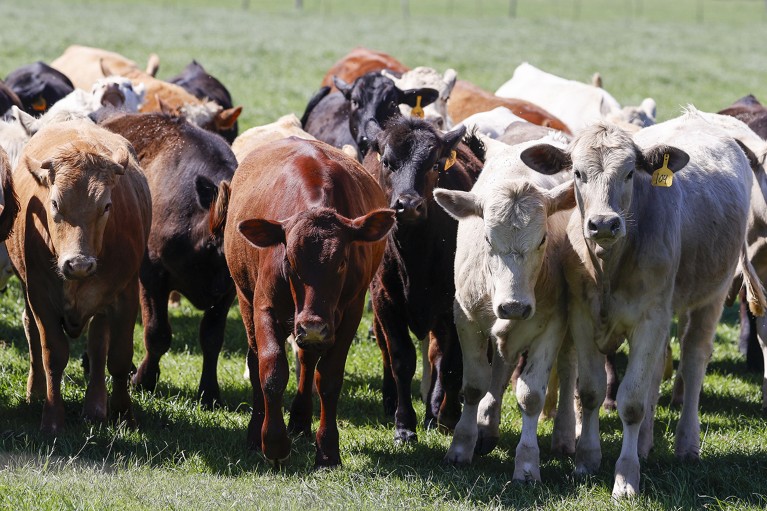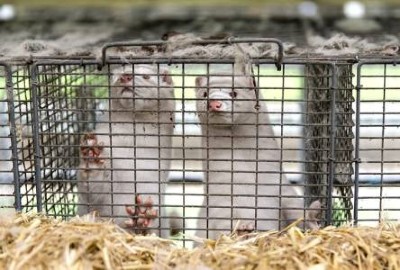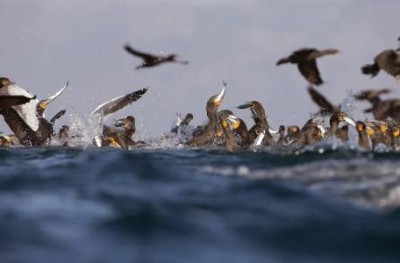[ad_1]

A dairy worker in Texas has become infected with a strain of avian influenza similar to that infecting dairy cattle in several US states.Credit: Adam Davis/EPA-EFE/Shutterstock
Researchers are closely monitoring the spread of a worrisome strain of avian influenza to cattle — and one person — at farms in six US states.
These infections represent the first widespread outbreak of bird flu in cows. The outbreak is concerning because humans frequently come into contact with cattle on farms, giving the virus ample opportunity to spread to people, says Daniel Goldhill, an evolutionary virologist at the Royal Veterinary College in Hatfield, UK.
Health officials have said that the overall threat to people remains low, for now, but they are watching the situation unfold closely. “There’s always a worry that viruses will surprise us,” Goldhill says. “We don’t know what they’ll do next.”
Scientists are scrambling to assess how well candidate vaccines and antiviral drugs will work against the circulating strain and to update diagnostic kits for identifying infections in people quickly. They are also trying to understand whether the cows were infected by birds or another source, and are on alert for any changes in the situation that could raise the risk for people.
“There are a lot of questions and, so far, not a lot of answers,” says Florian Krammer, a virologist at Icahn School of Medicine at Mount Sinai in New York City.
Where was the virus found previously, and what’s happening now?
In 1996, the influenza strain called H5N1 was first detected in birds in China. It has been spreading ferociously in birds since 2021, killing hundreds of millions of domestic and wild birds around the world. It has also occasionally infected mammals, including seals and bears, which have become “accidental hosts” of what is mostly an avian virus, says Kanta Subbarao, director of the World Health Organization (WHO) Collaborating Centre for Reference and Research on Influenza in Melbourne, Australia.
Bird flu outbreak in mink sparks concern about spread in people
In the past two weeks, health officials have detected H5N1 in cows from 16 herds across six states — a number that is likely to increase as US surveillance is stepped up. Researchers have previously documented1 sporadic infections of cows with flu viruses closely related to H5N1, but no widespread outbreaks had been detected until now.
The more mammalian species the virus infects, the more opportunities it has to evolve a strain that is dangerous to humans, Goldhill says. One dairy worker in Texas has been infected, but the US Centers for Disease Control and Prevention (CDC) reports that the person is recovering. The worker’s only symptom was eye inflammation, and viral levels in their nose were low, suggesting that they don’t have a respiratory infection, according to the CDC.
The virus infecting the worker is closely related to the strains found in dairy cattle in Texas, with one notable distinction: the worker’s variant has a mutation that is linked to more-efficient spread in mammals. Goldhill says the presence of the mutation in the human sample was not surprising; it has appeared many times, including in foxes2 and cats3 infected with H5N1.
Is the virus spreading between cows, and why does that matter?
A key question for researchers is how the cows are getting infected. The answer will be important for controlling H5N1’s spread to other farms and people. “This is a controllable situation, we just have to understand how this virus is getting around,” says Richard Webby, a virologist at St. Jude Children’s Research Hospital in Memphis, Tennessee.
Avian flu freezes coastal bird research in South Africa
Of particular interest is whether the virus is passing from infected cows to uninfected ones, because that would suggest the virus has become more adept at transmission in mammals. Given that the virus has been detected at several farms across the United States, epidemiological data make it “pretty clear now we’re seeing cow-to-cow spread”, and that wild birds are not necessarily involved in viral spread in the farms, says Webby. But there aren’t enough viral sequences of animals infected later in the outbreak for genomic data to confirm cow-to-cow spread, he says.
If the virus is spreading between cows, it will be important to work out precisely how, Webby says. Evidence so far suggest that virus levels are highest in the animals’ milk, according to a report in Science. That suggests that H5N1 might not be spreading between cows through the air, a transmission pathway that would be difficult to control and could allow for relatively quick spread, Webby says. If cows are becoming infected by touching contaminated surfaces, such as milking machines, the virus would be transmitted more slowly than if it is airborne.
Gathering evidence to address these questions could help to answer why infections have only recently cropped up in cattle, and only in the United States, despite the virus’s global spread in the past few years. Marion Koopmans, a virologist at Erasmus University Medical Center in Rotterdam, the Netherlands, wonders whether there is something unique about how cattle are kept in the region, for example, or whether the virus has gained new abilities to persist in the environment. Addressing these questions will offer insights into how widespread bird-flu infections could be in cattle globally, she says. It will be important for health officials outside the United States to start looking for evidence of overlooked outbreaks, Krammer says.
What would increase concern among researchers?
Scientists say that, although bird flu is unlikely to spread widely in people, they are closely monitoring samples of H5N1 globally for mutations known to signal that it is becoming better at spreading in mammals. The virus has not spread widely in humans in part because it can’t readily enter the cells that line the nose and mouth. But it would be problematic if the virus developed mutations that would help it to gain entry to these cells, Goldhill says.
Krammer says he would look specifically for changes to the section of the viral genome that encodes a type of enzyme known as a polymerase. A portion of this enzyme is known to be “a hotspot for adaptation to mammals”. Researchers are also looking out for mutations that would make the strain less susceptible to antiviral drugs, says Webby.
The animal that no virologist wants to see a flu outbreak in, is the pig. Pigs host many influenza A viruses, making them a ‘mixing vessel’ in which strains of avian and mammalian viruses can mix and match and become more efficient at transmitting to people, says Krammer.
What do we know about how well existing vaccines and drugs will work against this strain?
The WHO maintains a list of candidate vaccines that provide protection against H5N1 and that could be mass-produced. And some countries, including the United States, maintain a small stockpile of vaccine doses should they need to vaccinate at-risk populations, such as front-line workers.
The CDC has reported that the viral strain isolated from the infected person is closely related to two strains targeted by a candidate vaccine. Webby says that his team has confirmed in laboratory studies that the WHO vaccines can protect against viral samples collected from cows early in the outbreak, and they will continue to test new samples as the outbreak progresses. Specifically, the vaccine includes antibodies produced against a human H5N8 virus isolated in Russia and an avian H5N1 virus isolated in the United States. They can “recognize this cow virus very, very well”, says Webby.
It would be useful to get more information on how much immunity these candidate vaccines produce against the circulating strain, especially because people don’t have pre-existing protection against H5N1 and closely related viruses, says Subbarao.
[ad_2]
Source Article Link



